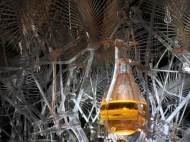Responsive protocells could be used to strengthen buildings
 Researchers from the University of Greenwich are using ethical synthetic biology to create “living” materials that could be used to clad buildings and absorb the CO2 from the air. In collaboration with an architectural practice and a building materials’ manufacturer, the idea is to use protocells – bubbles of oil in an aqueous fluid sensitive to light or different chemicals – to fix carbon from the atmosphere or to create a coral-like skin, which could protect buildings.
Researchers from the University of Greenwich are using ethical synthetic biology to create “living” materials that could be used to clad buildings and absorb the CO2 from the air. In collaboration with an architectural practice and a building materials’ manufacturer, the idea is to use protocells – bubbles of oil in an aqueous fluid sensitive to light or different chemicals – to fix carbon from the atmosphere or to create a coral-like skin, which could protect buildings.
“We want to use ethical synthetic biology to create large-scale, real world applications for buildings”, said Professor Neil Spiller, an architect and the new head of the University of Greenwich’s School of Architecture & Construction. Under his leadership, Greenwich’s School of Architecture & Construction is bringing a host of new technologies – such as nano, digital and synthetic biology technologies – into architectural practice.
The research team is looking at methods of using responsive protocells to clad cities in an ethical, green and sustainable way. Protocells made from oil droplets in water allow soluble chemicals to be exchanged between the drops and their surrounding solution.
Researchers from the University of Greenwich are also collaborating with others at the University of Southern Denmark, University of Glasgow and University College London (UCL) to develop materials that could eventually produce water in desert environments or harvest sunlight to produce biofuels.
The Center for Fundamental Living Technology at the University of Southern Denmark has managed to get cells to capture carbon dioxide from solution and convert it into carbon-containing materials. Such cells could be used to fix carbon to create ways of building carbon-negative architecture.
An installation displayed in the Canadian Pavilion in the Venice Biennale 2010, Hylozoic Ground, created by Canadian architect Philip Beesley, provides an example of how protocells could be used to create carbon-negative architectures. Protocells situated within the installation designed by Dr Rachel Armstrong, Teaching Fellow at UCL’s Bartlett School of Architecture, recycle carbon dioxide exhaled by visitors into carbon-containing solids. Similar deposits could be used to stabilize the city’s foundations by growing an artificial limestone reef beneath it.
“We want to use protocell bubbles to fix carbon or precipitate skin that we can then develop into a coral-like architecture, which could petrify the piles that support Venice to spread the structural weight-load of the city”, said Professor Spiller.









Leave your response!